The economic case for paternity leave
Suddenly last year, maternity leave got a makeover, courtesy of a most improbable source: Shinzo Abe.


Suddenly last year, maternity leave got a makeover, courtesy of a most improbable source: Shinzo Abe.
Japan’s prime minister is synonymous with machismo-spiked nationalism (he famously denied that women forced into sexual servitude by Japanese soldiers in World War II were ”coerced”). But when he unveiled his sweeping economic revival plan, it included longer leave for mothers. And this wasn’t the usual pastel-hued sop to women voters; the way Abe framed it, longer maternity leave was a shot in the arm of Japan’s moribund economy.
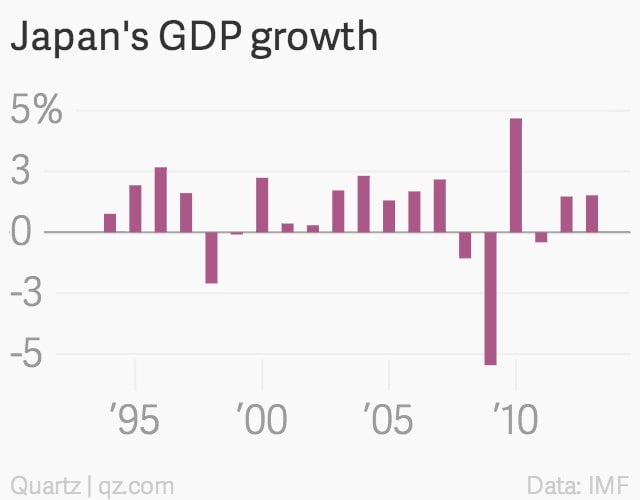
Though uncharacteristic, his reasoning made a certain sense.
Nearly two decades ago, Japan started running out of workers, dragging on economic growth. Making things worse is the fact that seven-tenths of Japanese women drop out of the workforce after having their first child. Getting them back to work could boost Japan’s GDP by as much as 15% (paywall), says Abe. And the way to do that was to make maternity leave longer.
Japan is hardly the only country that would benefit from keeping more mothers in the labor force. If American women worked at the same rates men did, US GDP could grow 9%, say economists; France’s would pop by more than 11%; and Italy’s would see a whopping 23% boost, according to OECD calculations. The average across the OECD would total 12%.
There’s only one problem with Abe’s plan: It’s targeting the wrong people. More maternity leave might sound like a great idea, but as long as mothers are the only parents taking leave, longer stints at home actually worsens job discrimination against them and makes them less likely to pursue a career.
Rather, as the experiences of Sweden, Iceland, and a handful of other countries show, the secret to keeping mothers in the workforce lies not in giving them more time off, but in getting more fathers to stay at home instead.
Why ”womenomics” works

There are lots of good arguments for adding more women to the workforce.
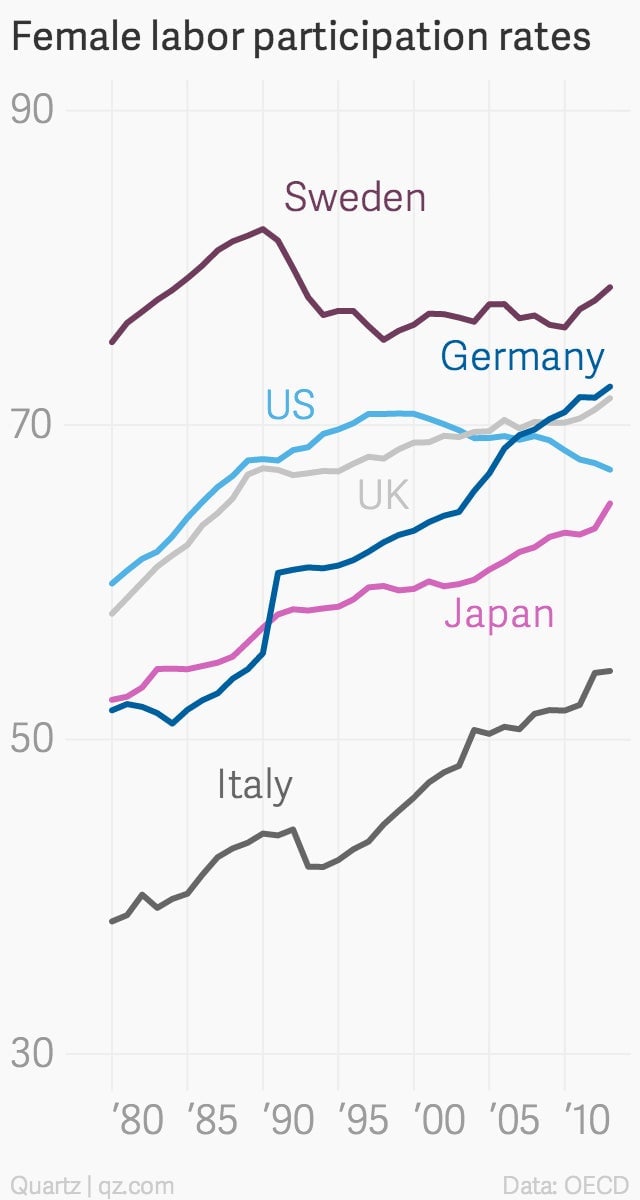
An economy grows when it adds more people to make things, or when the workers it has make things faster. Since upping productivity—as the latter option is called—is notoriously tricky, when an economy is stagnating it’s generally a good idea to scare up some new workers. Importing immigrants is one choice (that’s what the US favors). The other is simply nudging more of your working-age population into jobs. And in most developed countries, the biggest base of unemployed workers is women.
The benefits of upping the share of women working come in fits and starts. At first, it tends to lower productivity, partly because some of this additional female labor is usually part-time, and partly because new people need training.
Over time, however, influxes of women make a workforce not just bigger but also more productive. Firms in the top quartile for female senior managers earn 56% more than companies with none, according to McKinsey & Company. This may be because management teams with an equal gender balance tend to innovate more, make more informed decisions, and take fewer big risks. The share prices of companies with one or more women on the board outperform those with none, Credit Suisse research shows (pdf, p.12). Although that’s not a causal relationship, Credit Suisse cites research suggesting that greater gender diversity in leadership improves communication and reduces corrosive competition among senior managers.
There are other benefits to the economy too. Accounting for seven-tenths of global consumer spending, women are “the ultimate agents of aggregate demand,” says Christine Lagarde, head of the International Monetary Fund. Companies that design and market their goods and services in ways that appeal to women will sell more effectively than those that don’t. Companies led by talented women are more likely to pull that off.
Women also tend to spend more on healthcare and education. These services are more labor-intensive than most sectors, so they generate more jobs. And when these “agents of aggregate demand” earn more, they’ll spend more too.
Finally, women tend to invest a larger chunk of their income than men on their children’s well-being—or as economists call it, “human capital.” In the long term, this trend should help create a smarter, heartier talent pool.
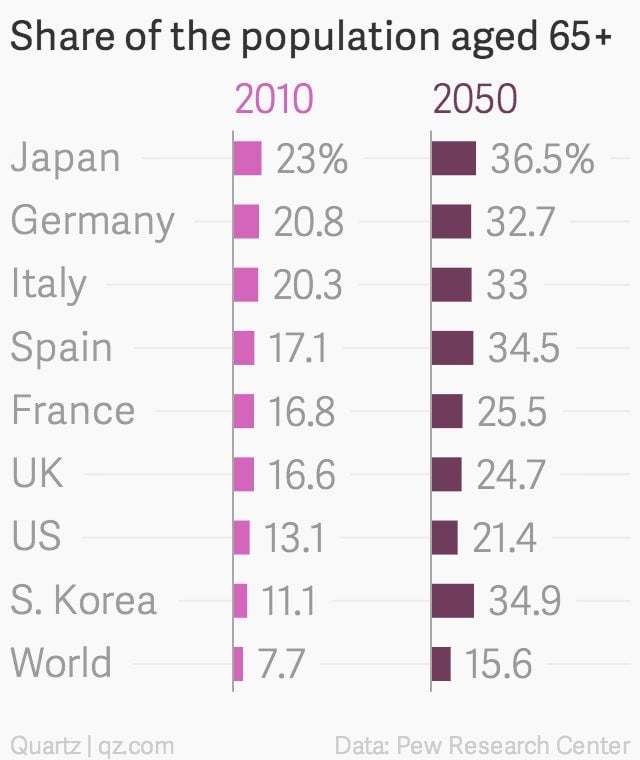
Of course, getting more women to work isn’t the only way to keep a country’s economy humming; you can also buy workers from other countries. The US prefers this approach, relying heavily on a temporary worker program to supplement its workforce. Immigrants are usually young and healthy, and therefore tend to contribute more taxes than they take in services from the state (even many illegal workers pay taxes). But the lack of employment protections or financial security means that they neither produce nor consume as much as they might. And the risk of a labor shortage always looms.
There’s one final reason to employ more women. Every major developed country is in the midst of an aging crisis. Women are having babies too slowly to replace the people bowing out of their workforces, causing an ever higher number of retirees to be supported by the taxes of an ever-shrinking number of workers.
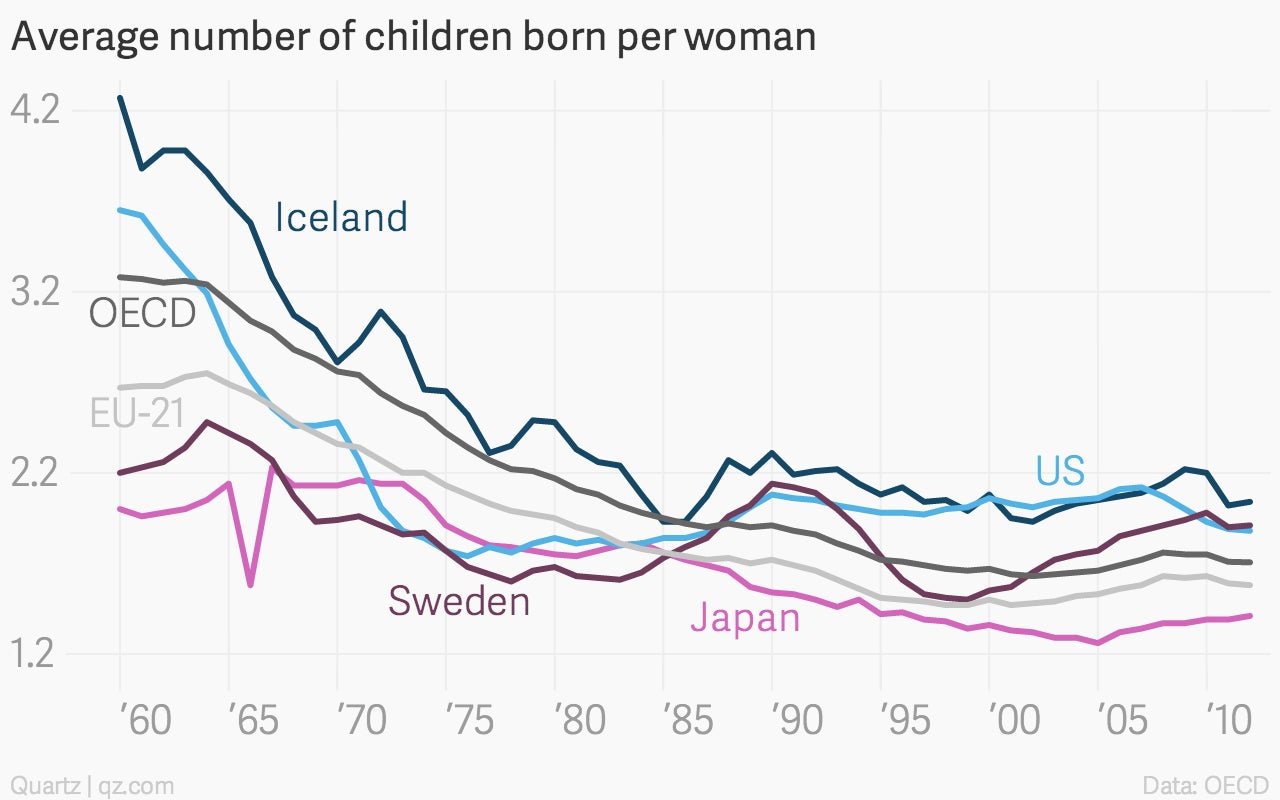
Paradoxically, upping female employment levels appears to stave off this peril. Women in countries with higher female employment rates give birth to more children, on average, according to Goldman Sachs (pdf, p.9).
The problem with maternity leave

So the case for getting more women working is clear. How to make it happen?
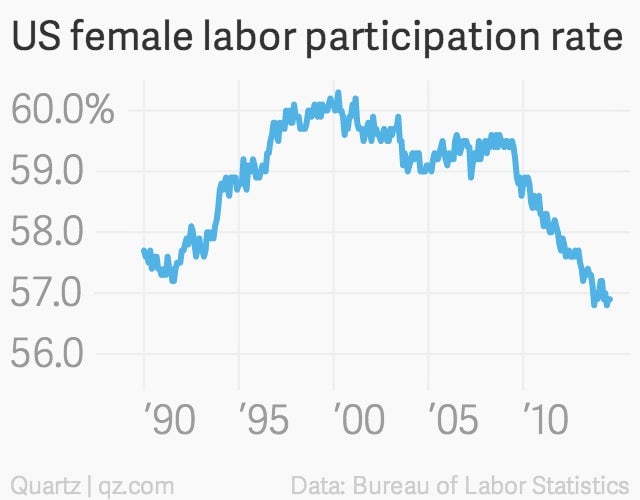
The standard answer is maternity leave. All over the globe, paid maternity leave policies have proven vital in boosting the likelihood that a new mother will return to work, and will put in more hours after she returns. Along with tax reform, these policies powered the surge in Europe’s female labor-force participation in the 1980s and ’90s. The US, however, stagnated. Whereas in 1990 the US had the sixth-highest rate of female labor participation in the OECD in 1990, within two decades it had plunged to 17th place. The US’s lack of paid parental leave and flexible work policies were responsible for nearly three-tenths of that drop, according to an oft-cited study (pdf) by Francine Blau and Lawrence Kahn of Cornell University.
But on its own, paid maternity leave works only up to a point. Even in euro-zone countries and others that have boosted the share of women in the workforce by offering lavish maternity leave and cheap childcare, the gap between male and female labor participation still yawns.
For the vast majority of women who don’t return to work after giving birth, this is because the costs of returning—both financial and psychological—outweigh the benefits.
Here are the factors they’re likely weighing. Since it’s assumed the mother will take a long maternal leave after giving birth, businesses systematically underpay women and skip them for promotions in favor of their male colleagues. Their husbands, therefore, likely have a much higher salary and aren’t eligible to take much more than a few weeks, at most, of paid childcare leave.
So women have little choice but to take many months off work to care for their newborn. Even in countries with robust maternal employment protections, low-skilled women in particular still face pressure to quit their jobs. Many who consider returning to work once their child is old enough for daycare struggle to find a job that pays well enough to cover childcare—or, with their skills now outdated, to find a job at all. Highly educated women, meanwhile, often find that taking a lengthy leave jolts them off the management track. And since this group tends to have wealthier husbands, without the professional motivation, there’s no point in returning.
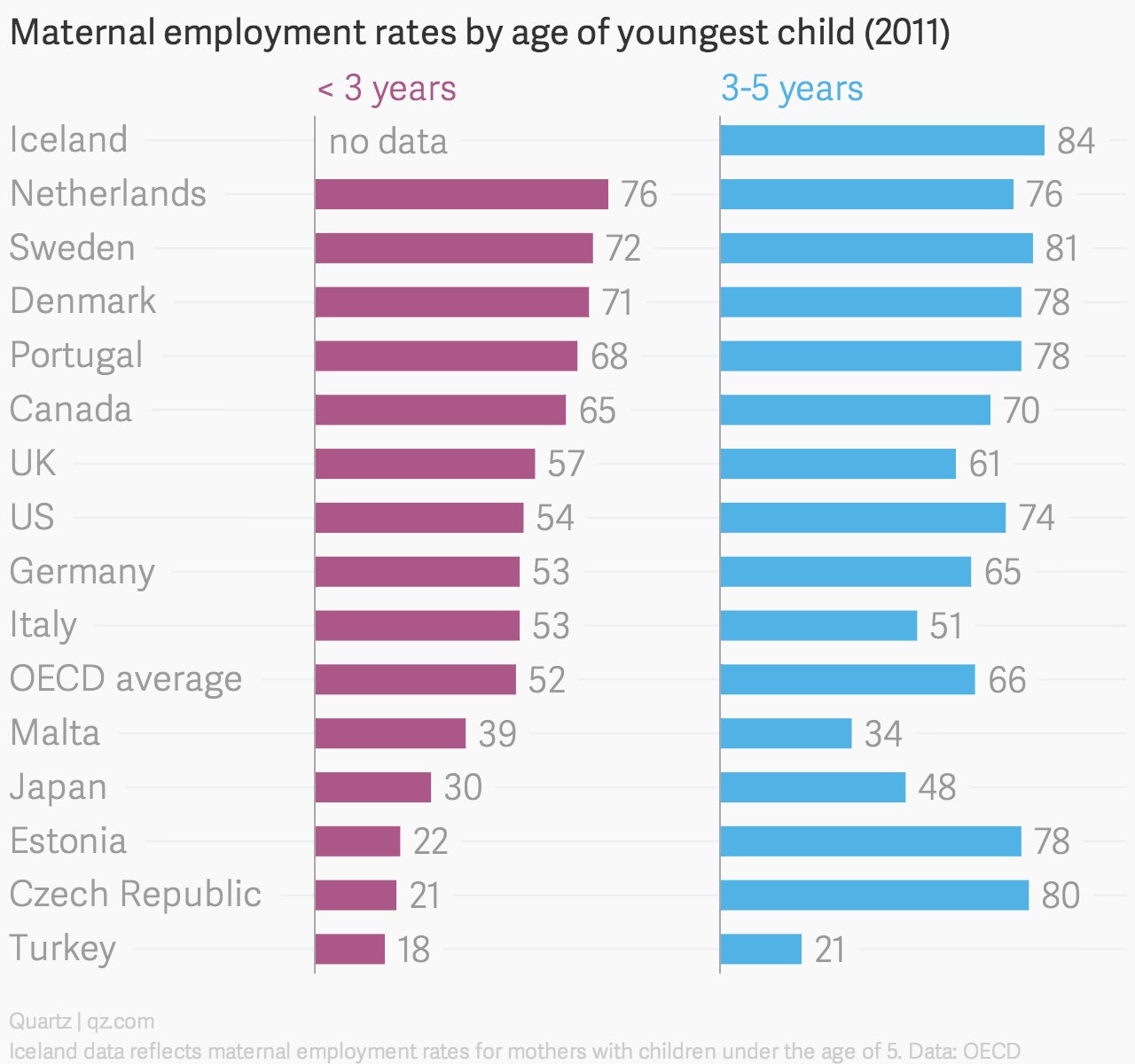
Treating women’s work as less valuable than men’s is considered sexist. But so, then, is paying mothers more money than fathers, and for much longer, to raise children. In fact, the two reinforce each other—something Japan’s dim history of female career advancement illustrates all too well.
Japan’s incredible shrinking workforce

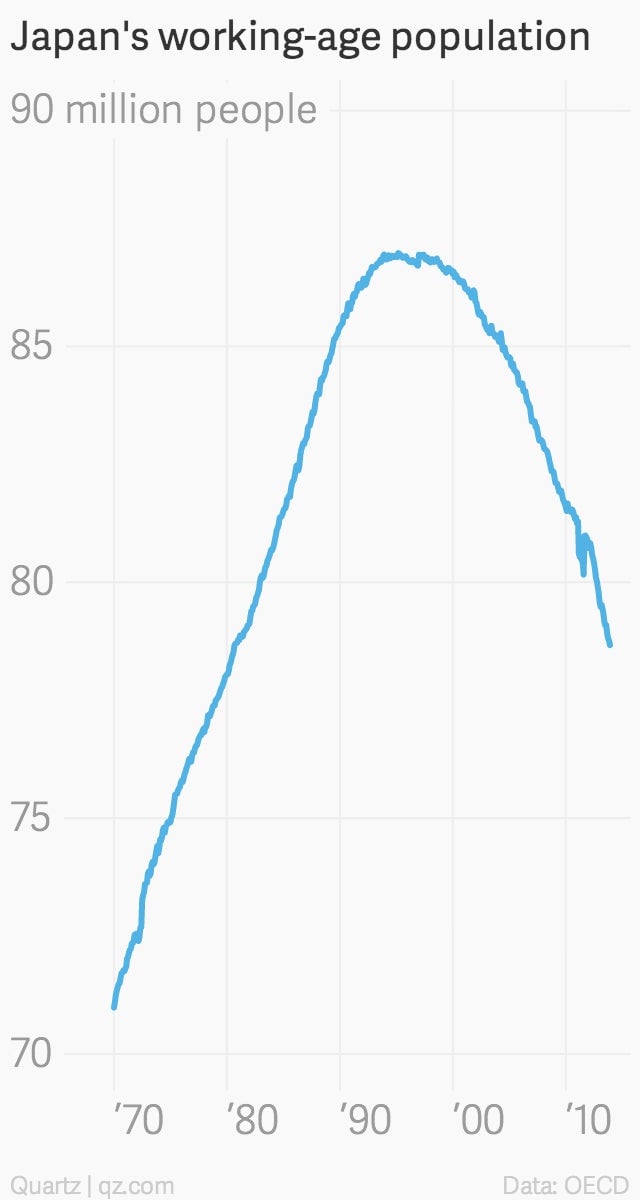
Japan has the biggest aging crisis of any country in the world. This isn’t a new problem; its working-age population peaked in 1995 at just shy of 87 million. But though Japan reformed its maternity leave policies repeatedly throughout the 2000s, some 7 million women remain out of the workforce for good. And instead of encouraging more babies, the policy has led birth rates to fall; Japan is one of the few countries in the world where pet dogs and cats outnumber children (pdf, p.4).
The funny thing is, women in Japan don’t start out working any less than in most other rich countries. The chart below tracks female labor-force participation, a measure that includes both those with jobs and those looking for work. Roughly the same percentage of Japanese women enter the workforce in their 20s as Sweden and the UK. But once they hit their 30s, things change—forming a trough in the composition of the labor force that demographers call the “m-curve”:
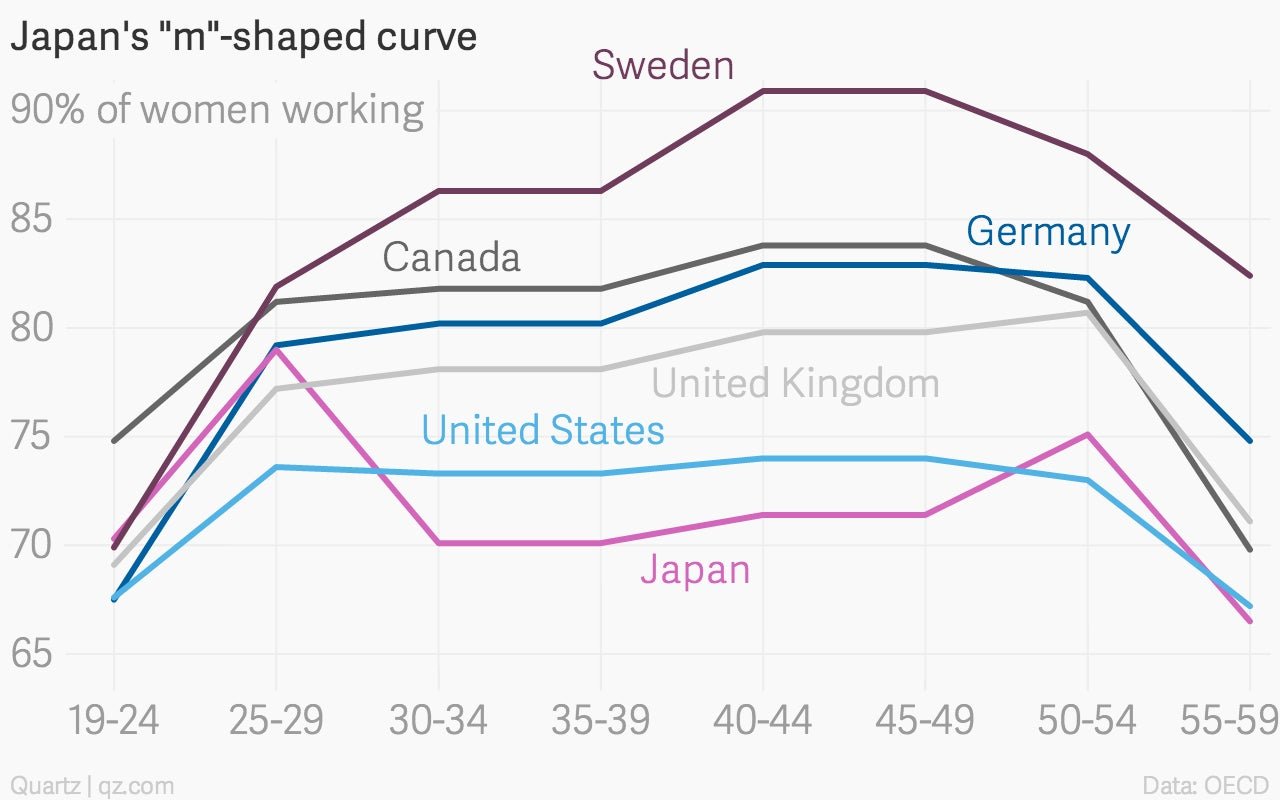
It’s not that they lack the skills to return. The women of Japan are better-educated than those of nearly any other country on the planet—in fact, more Japanese women enter university now than men.
But upon graduation, most of that learning gets tossed aside. Women are hired into what economist Noah Smith calls an “economic underclass,” with the majority in jobs with “low, stagnant salaries, few benefits, few guarantees and little if any possibility of promotion.” And as companies slot women into dead-end clerical jobs, they start grooming their male peers for promotion along the management track.
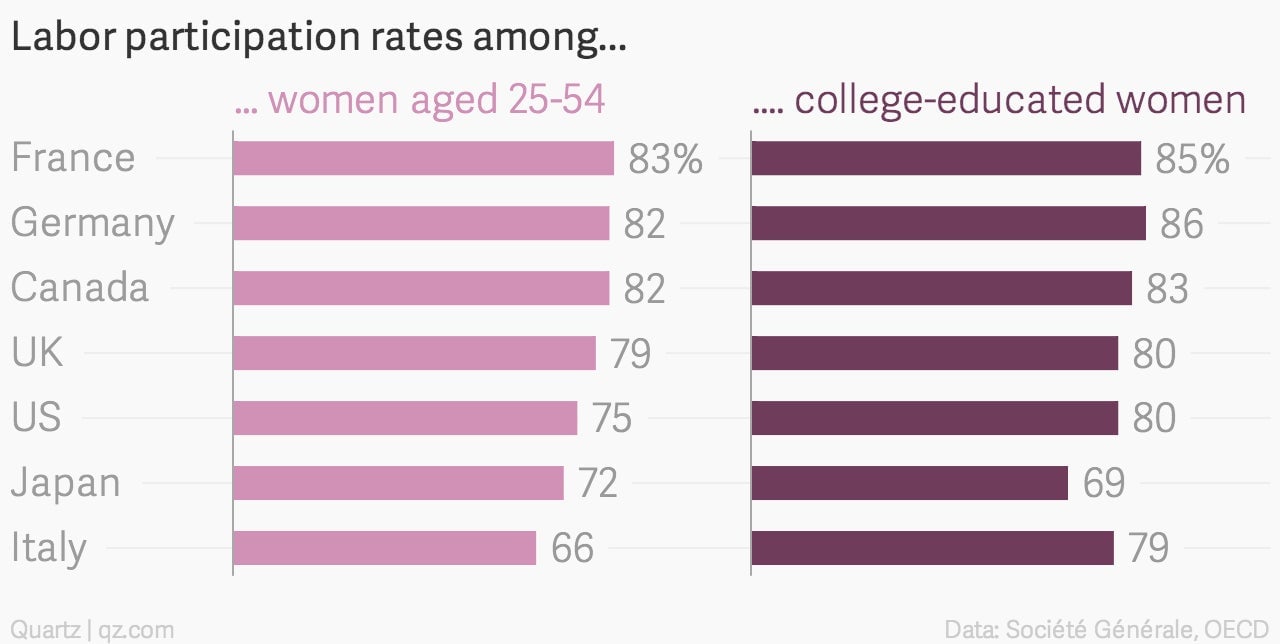
Though this two-track system smacks of sexism, from a human-resources perspective, it makes a crude kind of sense. That’s because government policy and Japanese culture make it hard for fathers to take leave, and unusually easy for mothers.
Japanese couples are currently allowed up to 12 months (pdf) of “childcare leave” to divide between them more or less as they see fit (and 14 months if the father takes at least two of them). The government pays the first six months at two-thirds of the parent’s salary, and the remaining months at 50%.
That might all seem very equitable. But in practice, maternal recovery and breastfeeding mean the mother is likely to take the earlier months—paid at two-thirds her wages. If the father takes the later months, he’ll get just half his wages. Since he on average makes 27% more than his wife, the more leave he takes, the more income the family loses. This has a predictable result: As of 2012, the last year for which there are data, only 1.9% of men (paywall) who were eligible for childcare leave actually took it, down from 2.6% (pdf, p.5) the previous year.
With that kind of policy, it’s no wonder companies don’t invest in women’s careers. Even if a female employee returns to work after having a baby, cultural norms mean that she’s going to raise the kid—and that makes her less likely to be able to put in long hours at work.
A policy supposedly meant to help women ends up penalizing them…

The trend is self-reinforcing. Once passed over for a management-track position, a woman has less motivation to work hard to advance her career. Since she won’t have been exposed to the same range or depth of experience as her male colleagues, she’ll be less competitive next time she tries to find work. Even if she’s a candidate for a career-advancing job, her manager—who is most likely to be a man—doesn’t have an incentive to give her a flexible work schedule to fit around parenting, as he’ll have plenty of other male employees willing to put in the long hours.
Women in Japan are already paid only 73% of what men make for the equivalent jobs; the fact that this gap grows during childbearing years suggests what some call a “motherhood pay penalty.” The work women can find after having a child is often part-time, and usually less well paid, so they have less incentive to go back to work. It’s telling that the better educated a woman is, the more likely she is to stay out of the workforce.

Oddly enough, men don’t have it so great either. In return for job security, companies expect their male employees to work grueling hours that end in booze-drenched after-hours bonding sessions, week after week for their entire career. Until very recently, to test their commitment companies would deliberately transfer male workers away from their families for a year or two. This peer pressure is also part of why Japanese men seldom take vacation days.
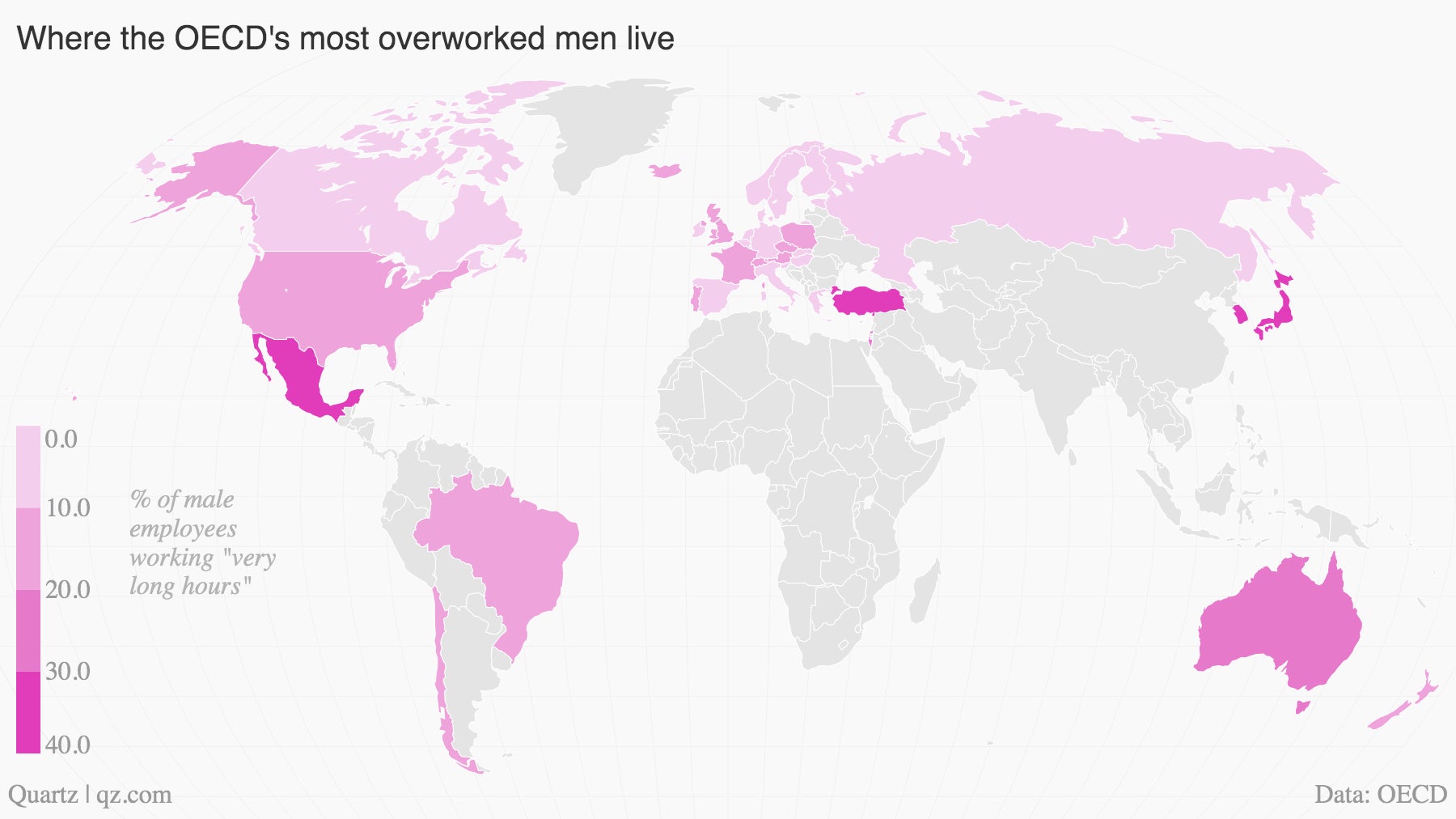
This isn’t especially good for the economy. Chronic overwork doesn’t mean more work actually gets done; in fact it’s thought to be one of the factors driving down Japan’s productivity. (Another factor is likely part-time workers, who tend to be less productive.) But because it functions like a form of professional hazing—no one wants to risk looking lazy or uncommitted—it persists.
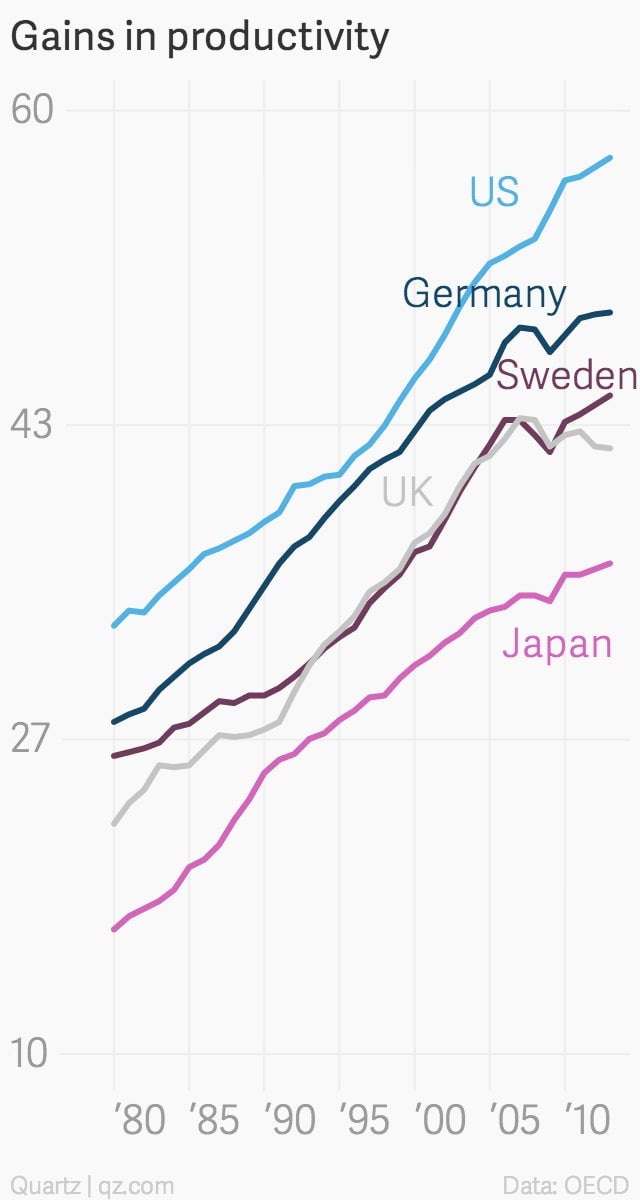
Men understandably get resentful about these extra hours, which is part of why the few men who do elect to take parental leave fear reprisals from both management and peers. ”If a male worker announces that he is going to take paternity leave, people around him start to doubt his suitability for the job,” said Tetsuya Ando, who founded an support group for fathers called Fathering Japan in 2005, told Reuters in 2010.
That stigma can be overt, says Matthew Apple, a college professor who has lived and worked in Japan since 1999, and runs a blog called Taking Leave about his experiences raising a family there. Apple opted to take parental leave after he and his Japanese wife had a daughter. When he returned to work, some of his more conservative colleagues stopped talking to him and successfully lobbied for his workload to increase to make up for his absence. For women, though it is worse; one of Apple’s female colleagues was pressured to quit after taking maternity leave (she ultimately triumphed in keeping her job, though she made a lot of enemies in the process, he says).
…and the policy encouraging paternity leave is too weak
That culture is gradually starting to change, says Apple, particularly among younger men. To the government’s credit, in 2011 it launched the Ikumen Project (the word is a slangy play on ikemen, which means a “good-looking man,” and iku (育), which means “to raise”), an online community that 2011 encourages fathers to take a more active role in child-rearing.

Another cultural milestone occurred in Aug. 2014, when Masako Mori, the minister then in charge of the declining birthrate and gender equality, declared that she would promote men who take “paternity leave,” by which she probably meant parental leave. Abe now says he wants the number of men taking leave to rise from 1.9% to 13% by 2020.
However, it’s not clear that this is much more than rhetoric. The salary gap between men and women means it still usually makes more economic sense for fathers to keep working, especially given that they’re likely to get only half their wages during parental leave.
So what the Japanese government ought to do is fix this disparity in how men’s and women’s time is valued. Instead, it’s considering making it worse, by extending maternity leave to three years. That would further entrench the traditional divide between men’s and women’s work, worsening Japan’s labor-supply problems and keeping GDP growth anemic at best.
Indeed, this makes it look as if Shinzo Abe’s agenda is less about jump-starting the economy than about trying to boost birth rates—despite the ample evidence that longer maternity leave will bring them down instead.
Japan’s dads aren’t the only ones stuck at the office

Governments can hardly expect businesses to compensate women’s time equally with men’s when their own leave policies pay fathers less than mothers for providing childcare. Only when governments and companies value women’s and men’s work the same—in both the workplace and the nursery—will this handicap against women lift.
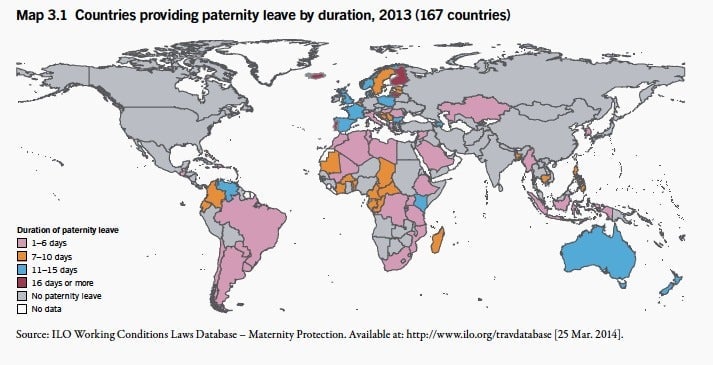
Japan is hardly alone in failing to grasp this, however. More than 100 countries now provide government-funded cash benefits for maternity leave; only 70 offer paid paternity leave. Even among OECD countries, just two-thirds offer paid leave for fathers, and even those often for no more than a few weeks. Only three countries—Chile, Portugal, and Italy—make paternity leave compulsory, though only for a few days.
For those that do offer longer leave for fathers, compensation often determines take-up. The lower the percentage of salary the government offers a stay-at-home parent, the bigger the penalty to the family if it’s the higher earner—usually, the father—who stays at home.
A concern about European policies is that they encourage women to settle for part-time work and for mommy-track career paths. The study by Blau and Kahn found that American women were more likely than those of the rest of the OECD to work full-time and to occupy managerial positions. Two major reasons, they note, are that Europe’s much more ”family-friendly” policies make it easier for less career-oriented women to stay in the workforce and for more ambitious women to shift into part-time work without sacrificing as much. In the US, by comparison, those two types of women are either dropping out, or forsaking babies for the corner office.
How Sweden finally revolutionized parenting

Though the Sweden of stereotype might be a machismo-free festival of gender neutrality, in the mid-1970s it wasn’t markedly different from today’s Japan. Hardly any dads took time off after the birth of a child.
That didn’t change even after Sweden scrapped maternity leave in 1974 and—like Japan today—replaced it with an overall allotment of paid parental leave that could be shared however the mother and father chose. Fathers who took time off were derisively nicknamed velourman or velourpappa (“velour men” or “velour dads“)—a reference to the fabric popular in unisex clothes at the time—and disdained for being unmanly. In 1974, only 562 dads claimed parental leave—about 0.5%.
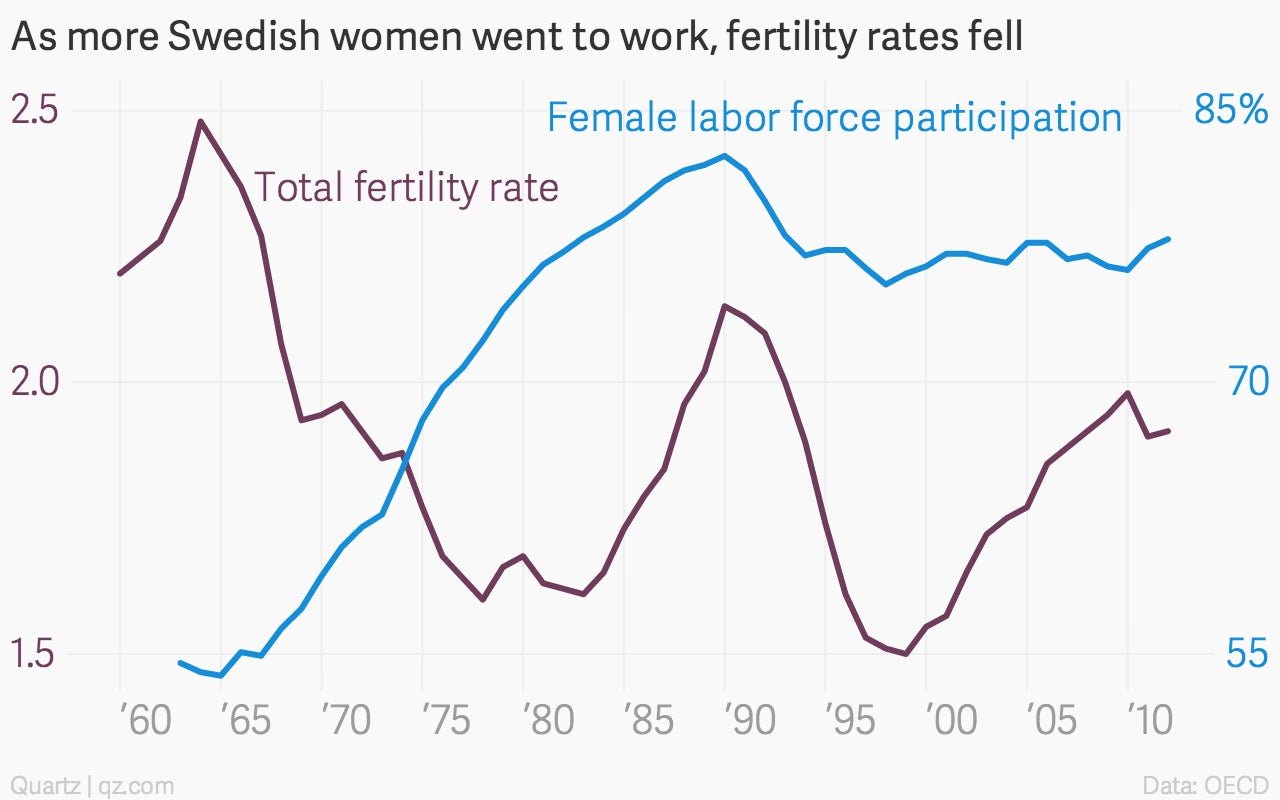
Sweden really needed these policies to work. Like many countries today, it had succeeded in boosting female labor participation, but at the cost of a decline in births. The government took a distinctly Shinzo-Abe-like approach, upping the length of parental leave four times in two decades; by 1994, leave lasted 15 months.
That revived fertility somewhat. However, by the early 1990s, it began slipping again. Then things got even bleaker: Sweden was hit with a massive financial crisis, driving unemployment to 12.9% in Jan. 1995 (pdf) and straining family finances around the country. Female labor participation began falling, as did the birth rate. Meanwhile, the rate of fathers taking leave had only risen to about 6%.
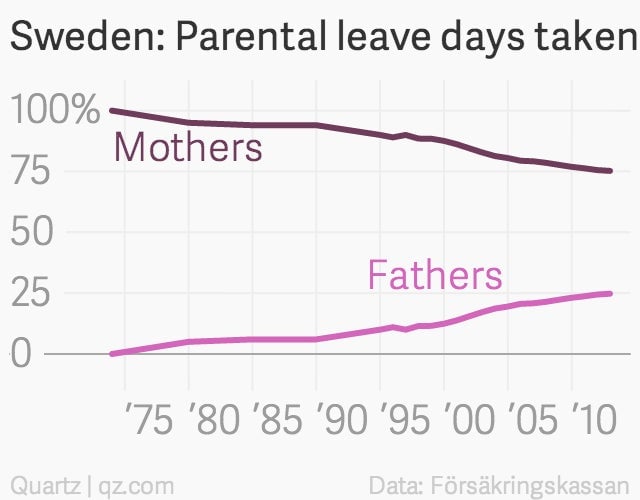
Why wasn’t it working? It turned out that allowing parents to choose how to divvy up childcare time didn’t much change the existing incentives. As Bengt Westerberg, who was deputy prime minister in 1995, told the New York Times (paywall), Swedish women faced a vicious cycle. Since women’s pay was at that time typically much lower than their husbands’, couples typically opted for the mother to stay at home with the child. But that perpetuated the pay gap, as women continued to be “mommy-tracked,” penalized for the possibility that they’d bear a child. Companies entrenched this divide by looking down on fathers who did take parental leave. Again, this is exactly what’s going on in Japan today.
“Society is a mirror of the family,” Westerberg told the Times. “The only way to achieve equality in society is to achieve equality in the home. Getting fathers to share the parental leave is an essential part of that.”
So in 1995, the government rolled out “daddy leave.” It didn’t make paternity leave mandatory, but couples lost a month of subsidized leave if the father took less than a month off. That meant he could no longer transfer all of his leave to his wife. The new policy also compensated fathers and mothers at 90% of their wages, making it harder for fathers to turn down.
And it worked. Within a few years, more than four out of every five fathers stayed at home. And when the government added another month to “daddy leave” in 2002, the amount of time they took off more than doubled. The government also upped the reimbursement ceiling to make the package more attractive to high-earning men.
As it stands now, each parent gets a 60-day “daddy” and “mommy” quota (pdf, p.2) paid at 78% of earnings—all of which must be taken. After that, the couple has 270 days paid at 78% of earnings to split as they choose, followed by another 90 paid at a flat rate. Parents also get additional part-time leave and the right to flexible hours up until their child is eight years old.
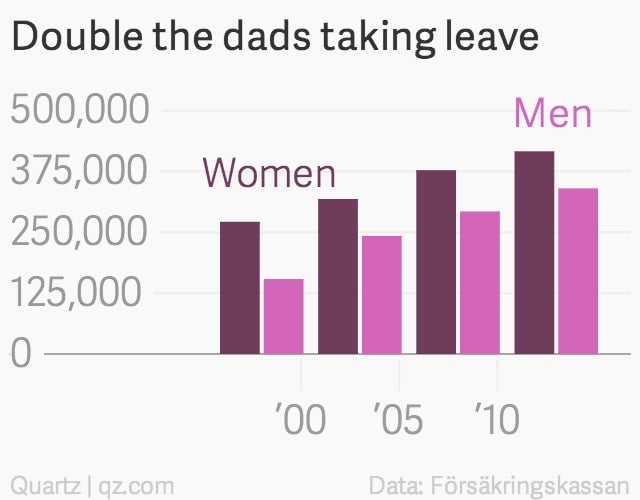
Now nine in 10 Swedish fathers take leave, for an average of three to four months each, accounting for a quarter of total leave time taken, and smoothing the mother’s transition back to work.
One reason this works is that Sweden pays generous benefits for a relatively short period of leave. Instead of encouraging women to spend a long time out of the workforce, it institutionalizes a set time when they must return to work or lose their paychecks. The addition of daddy leave adds extra time that an infant can spend with its parents.
Good for children, good for parents, good for the economy

What happened as a result? The issue is still controversial, but it seems that the longer the leave for fathers, the less time women take out from the job market. A study by the Swedish Institute of Labor Market Policy Evaluation in 2010 found that a mother’s future earnings rose 7% (pdf, p.35), on average, for each month of parental leave her husband took. Sweden now has some of the highest rates of working mothers in the world, with around nine-tenths of mothers (pdf) returning to work after childbirth. While some economists have worried that Sweden’s generous leave benefits (in addition to daddy leave) would penalize women, that hasn’t happened (pdf). Research shows that younger female workers face virtually no discrimination.
This doesn’t mean Sweden doesn’t have farther to go. Thanks in part to the disproportionate number of male physicians and its robust finance industry, Sweden’s pay gap is still relatively high. And as with everywhere else in the developed world, women also work part-time at higher rates than men.
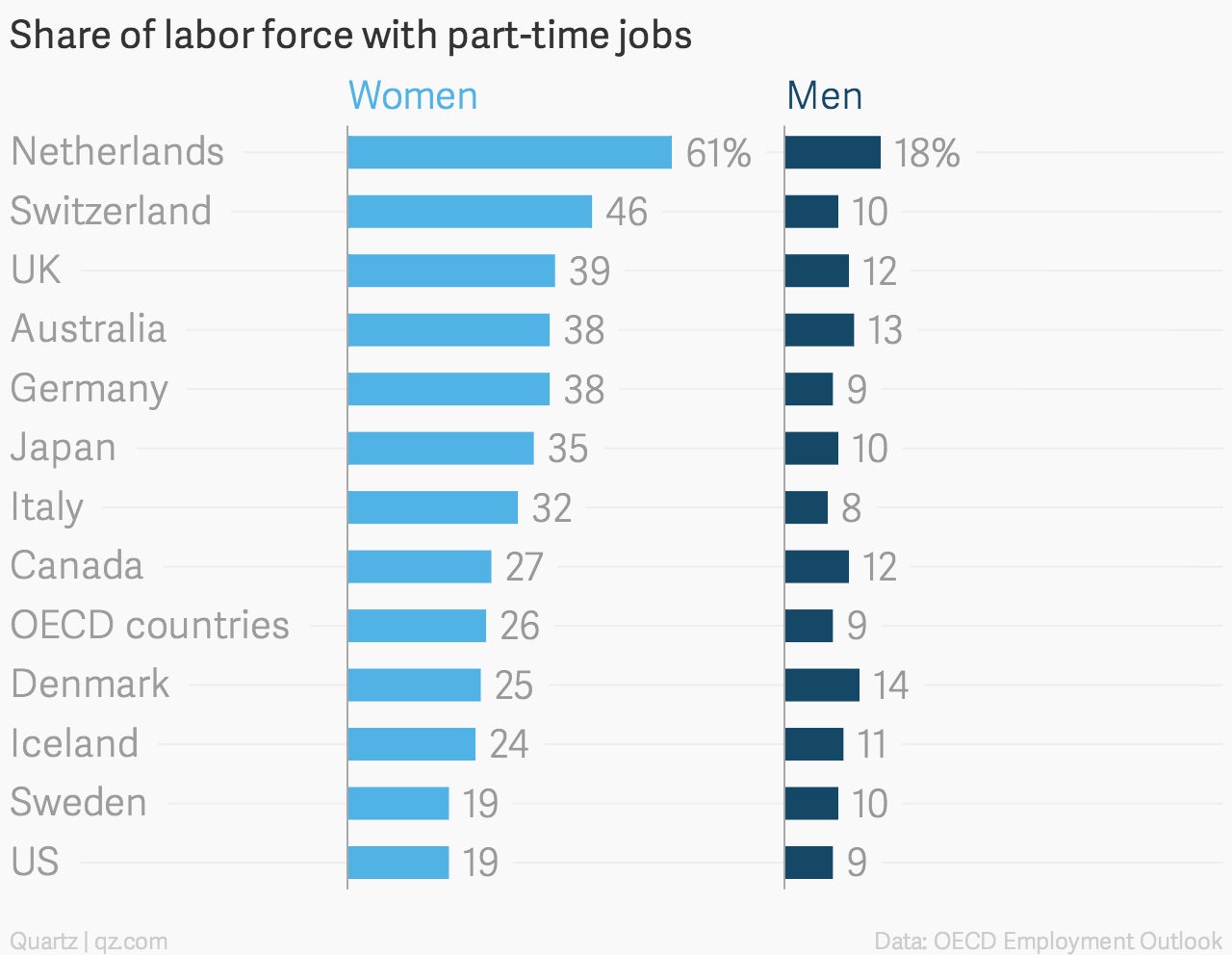
However, Sweden’s part-time work gender gap is much smaller than that of other countries. And unlike pretty much any other country, Swedish women who work part-time are paid at the same rate as those who work full-time, according to a 2008 study (pdf, p.58); some even enjoy a small pay premium.
The difference between Sweden and other countries, said the researchers, was that many of the Swedish women working part-time were still doing the same job they had in the past—and the same one to which they would return full-time after their children entered school. To put it another way, Sweden’s policies made it easier for parents to balance work and family responsibilities.
Other countries and states have won similar successes to Sweden’s. In the early 2000s, Iceland expanded parental leave to nine months, with a daddy quota of three months. Last year, Iceland granted each parent five months’ leave, with two months split however they choose. Though we’ll have to wait to see how that plays out, as of 2010, 95 fathers there took leave (pdf) for every 100 mothers that did. The fathers used roughly a third of the total parental leave taken, compared with just 3% in 2000 (pdf). In Quebec, too, a policy that split parental leave more fairly upped the likelihood that women returned to employment after leave.
Also worth noting is that Sweden and Iceland have put in place flexible-hours policies that apply for years after parental leave is over. In addition to upping the rate and duration at which new mothers breastfeed, these appear to have helped promote a more general workplace culture of flexibility that benefits all workers.
Uneven playing field, uneven pay
In summary, giving men an incentive to take paternity leave appears to do two things for women’s careers: It gets them back in the workforce quicker, and boosts their long-term earning potential.
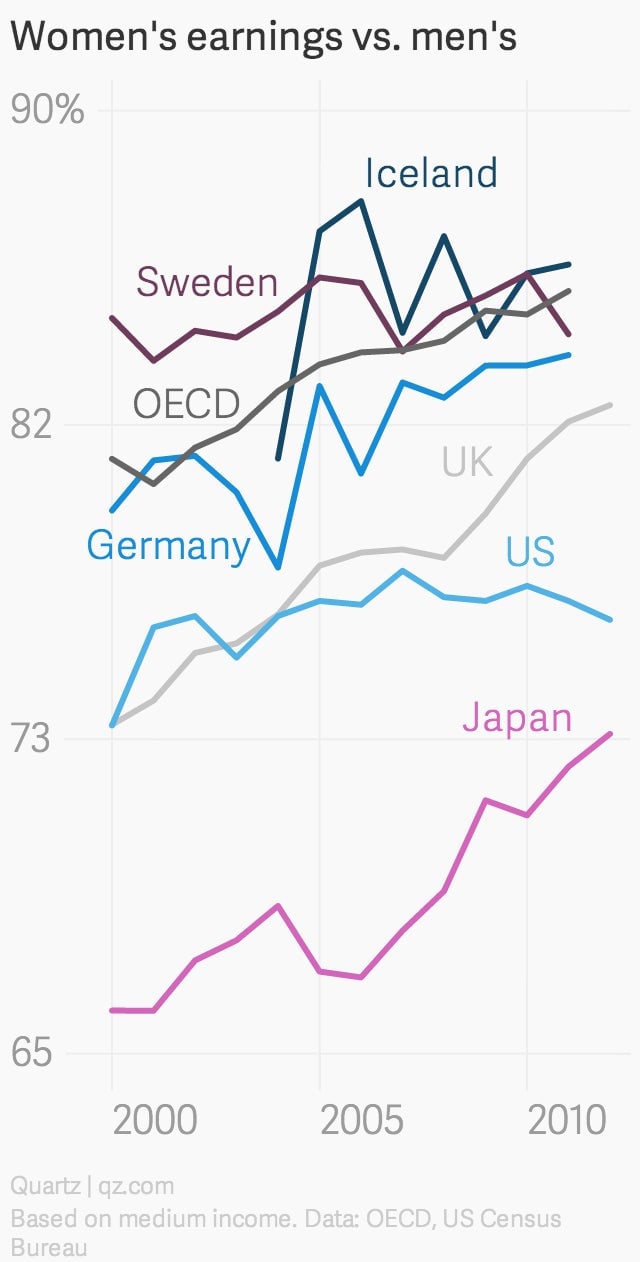
The latter is an important factor in closing the pay gap. This isn’t just good for women, but good for the economy too. As we saw in the Japan example, a pay gap discourages highly-educated women in particular from returning to the workforce full-time after having children. It’s also lost income for the government in terms of the taxes it would collect on a full-time salary if the wage gap disappeared.
Of course, something has to foot the bill for slashing that wage gap. And that something is companies. But while you might assume that they’d secretly object to paying any employees more, it turns out losing workers to motherhood isn’t so great for the bottom line.
First off, it limits the return on investment in those lost workers’ training. It also means a hit to productivity, as companies must spend on replacing lost employees and then training those new workers. In a study in California (pdf) and another in New Jersey (pdf, p.2)—which, along with Rhode Island, are the only US states to provide paid parental leave—companies reported that the policies helped them retain workers and caused either no change to their bottom line, or in some cases cut training and turnover costs. New mothers in both California and New Jersey were much more likely to return to work.
If you want women to work, you have to pay for childcare

To be sure, one reason Scandinavia was able to pioneer all this is that its tax rates are already among the world’s steepest. Though Swedish-style policies will go into effect in the UK in 2015, passing such sweeping legislation will be harder in European countries under the yoke of austerity. As for the US, though several senators are pushing for new legislation on parental leave, financing it will be controversial; expect outrage from those whose knees jerk in chronic opposition to Nordic “wealth redistribution.”
But looked at another way, increasing taxes to pay for daddy leave isn’t wealth redistribution, but simple market economics. If the state wants men to take time out of the workforce, it has to compete with the salaries they could earn by staying in the workforce. In other words, it has to pay them the market rate for work—the work of childcare—that it has long gotten much more cheaply from women.
This brings us back to the original point. Whether a country needs a bigger workforce now or down the road, encouraging only women to specialize in the business of childcare will doom those plans to failure. It’s hard for women to stay in the workforce when businesses undervalue their official work and governments undervalue their husbands’ childcare. In the long run, countries that make sure parents, regardless of their gender, can wring the greatest possible value from their time and skills will be those whose economies and families thrive.